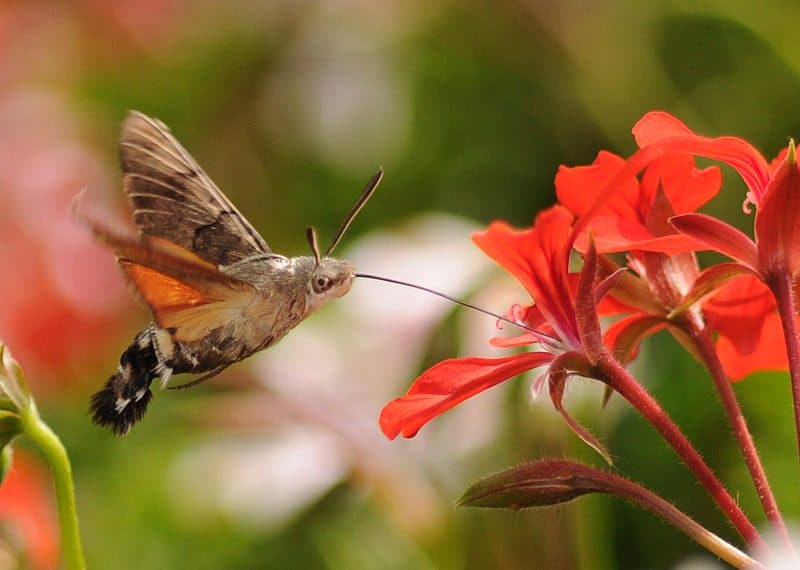
Hummingbird Hawk Moth Facts
- This Lepidoptera primarily goes by the common name of the Hummingbird Hawk Moth. Entomologists, however, know it better by its official scientific name. That, though, is the hard to pronounce term of Macroglossum stellatarum.
- Whatever name one chooses to use to refer to it, it’s a fabulous creature. The first recognition of it as a separate and distinct species, meanwhile, occurred in the year 1758. It further owes its acknowledgement to a famous name in science.
- That’s because the famous Swedish botanist, Carl Linnaeus, made that original scientific classification of the species. He also published it in the 10th edition of his Systema Naturae. This gives the insect a historic place in the annals of entomology.
- Its relative fame doesn’t end there, though. That’s due to the fact that it held a place in important, groundbreaking scientific studies. More precisely, in 2018, a lengthy and detailed project completed the sequencing of its entire genome and mitogenome.
- There’s also more good news. For the moment, the Hummingbird Hawk Moth appears to be maintaining a sizeable and stable population. This delightful trend further seems to hold true throughout the entirety of its natural range.
- The IUCN, therefore, presently has no listing for it on the organizations Red List of Threatened Species. The species nonetheless could face threats to its existence in the future. That’s because habitat loss and climate change continue to escalate.
Related Articles
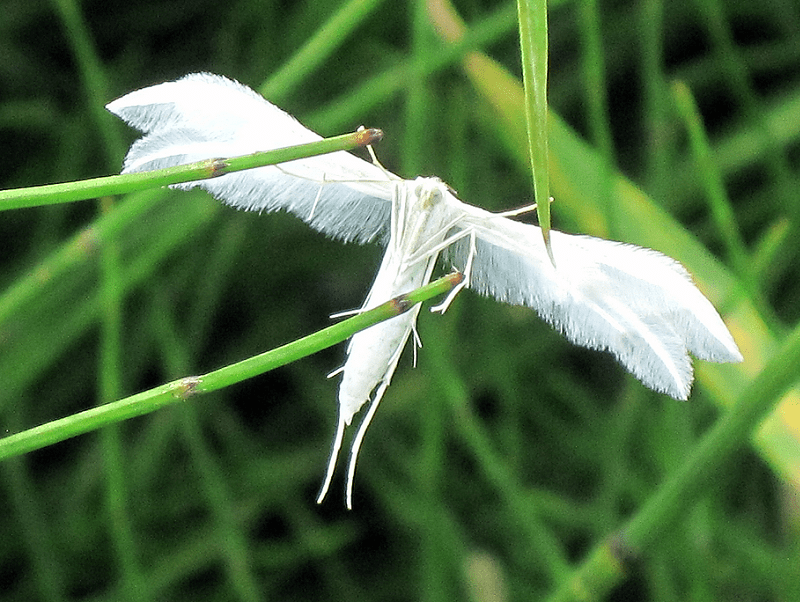

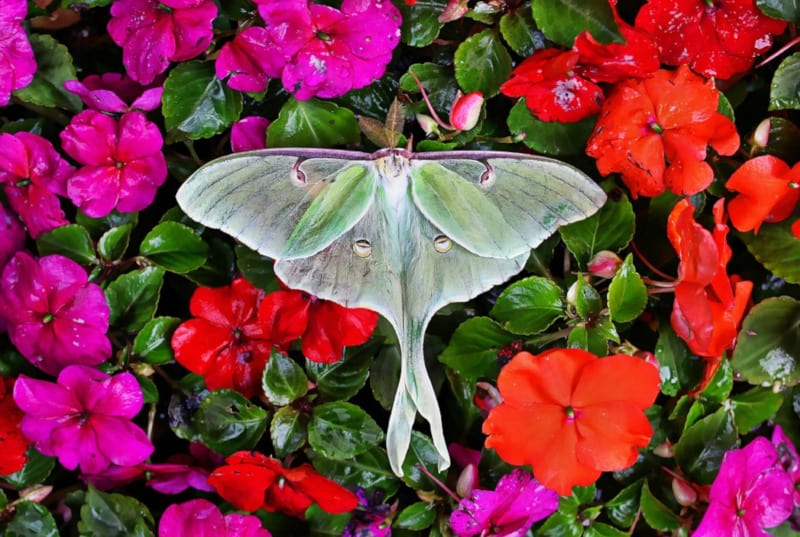
Hummingbird Hawk Moth Physical Description
The magnificent Hummingbird Hawk Moth adroitly proves that size holds no relation to beauty in Nature. This holds true since it only qualifies as a medium-sized type of moth, in terms of wingspan. Also unusually, it shows no noticeable sign of sexual dimorphism.
This lack of visual difference between the genders extends to both size and appearance. As a result, mature specimens of both sexes attain an average wingspan of about 1.8 in (4.6 cm). While not large, those wings nevertheless impress one, just due to their beauty.
The forewings typically show brown and a crisscrossing of thin black lines. The hind wings of the arthropod, though, usually show orange and display a black edge. Although the wings grow medium-sized, the body remains proportionately larger than related species.
The proboscis of the amazing Hummingbird Hawk Moth, however, developed in a remarkable manner. It’s highly elongated, again mimicking the hummingbird. The arthropod even possesses a short tail tipped with numerous soft, brush-like bristles.
- Kingdom: Animalia
- Phylum: Arthropoda
- Class: Insecta
- Order: Lepidoptera
- Family: Sphingidae
- Genus: Macroglossum
- Species: M. stellatarum
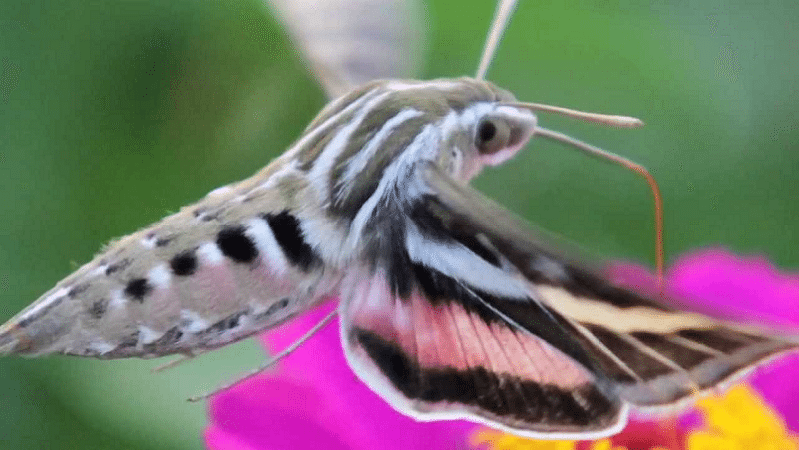
Hummingbird Hawk Moth Distribution, Habitat, and Ecology
The marvelous Hummingbird Hawk Moth possesses yet another strong evolutionary advantage. That’s the fact that it evolved as native to a huge portion of the globe. More precisely, its natural distribution covers much of Asia, Africa, and also Northern Europe.
Even beyond that, most individuals develop as relatively strong fliers. As a result, the species appears virtually anywhere in the hemisphere during the summer. This represents yet another manner in which it differentiates itself from the majority of its peers.
Adding even more to its resume, the amazing invertebrate also evolved as highly adaptable. Due to that trait, it often inhabits a wide variety of habitats. These include regions as diverse as forests, meadows, parks, and even private gardens around human habitations.
Unfortunately for its fans, though, it has a short lifespan. Because of this trait, however, it developed another helpful trait. The marvel of Nature breeds quickly. Therefore, anywhere from 2-4 generations are born in a single season. This often depends on the region, as well.
The mature adults of the Hummingbird Hawk Moth feed exclusively on nectar from plants such as the Red Valerian and Honeysuckle. Thankfully, the species itself, however, has few natural predators. This mainly holds true due to its incredible camouflage.
Species Sharing Its Range
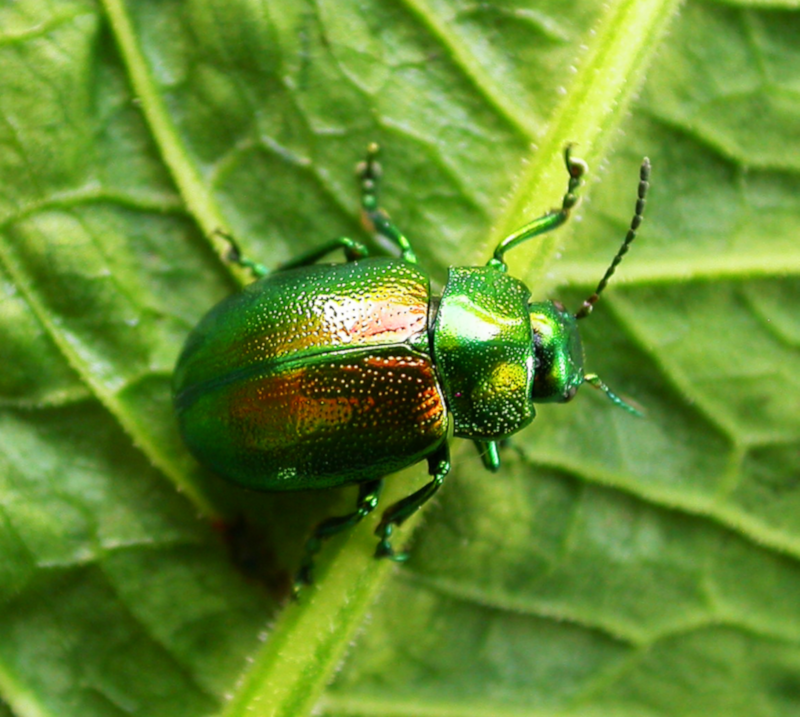
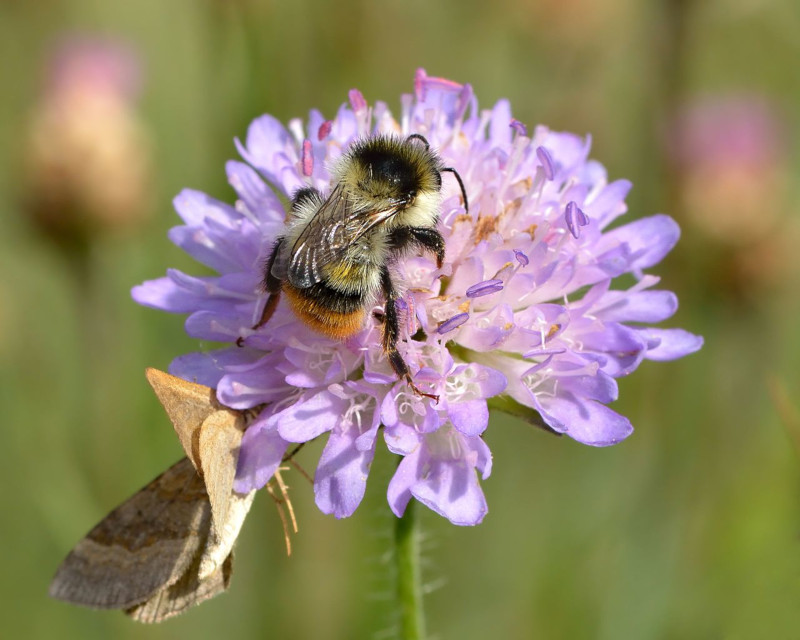
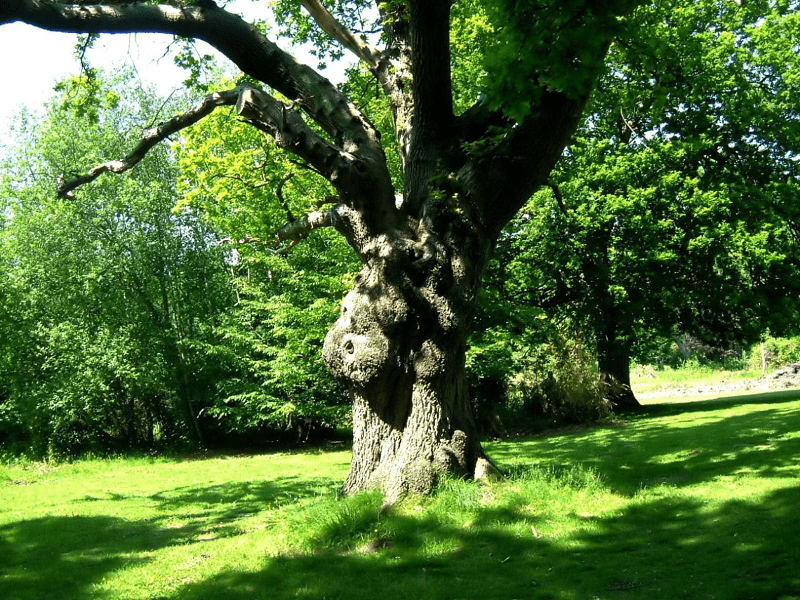
Check out our other articles on 5 Fabulous Deer Varieties, Tassled Scorpionfish, Erta Ale, Eastern Diamondback Rattlesnake, Chatham Island forget-me-not, Pacu, Australian Sea Lion
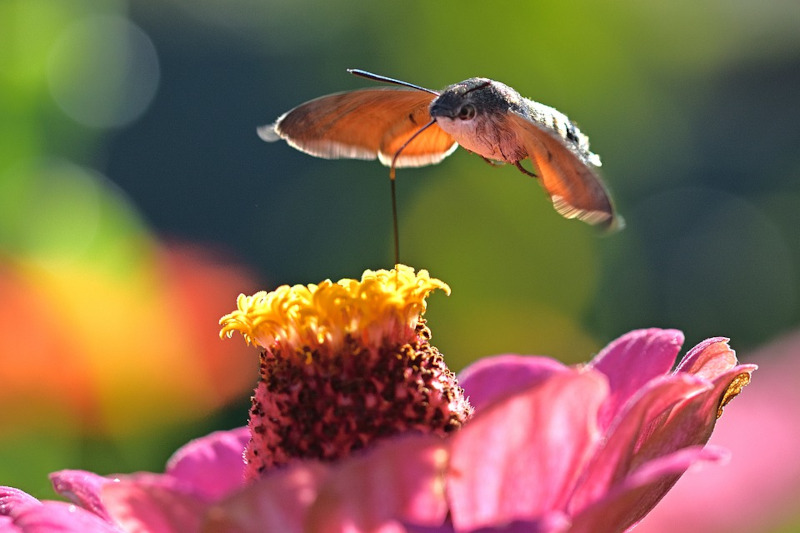









Saw one of these years ago in Connecticut feeding on thistle flowers often wondered what it was .
Hello Kenneth,
Thank you for your comment. They are remarkable, aren’t they? It must have made an impression on you to remember it after so long. We hope you are fortunate enough to see more of them.
Sincerely,
OBP
i saw one for a few days loving the Abelia edward shrub in our garden. it was wonderful.
Hello Patricia,
Excellent! That must have been a lovely sight for you! Thank you for sharing this with us.
Sincerely,
OBP
Just saw one today in Palmer Rapids Ontario Canada
Just had one on my doorstep in Alberta, Canada. What a beautiful experience!
A few evenings ago at dusk, I saw several of them, of different sizes, fly out from the dense branches of my tall purple fountain beech tree. They magically swarmed about and then all suddenly turned together and flew into the woods. I was pleasantly stunned, wondering what on earth I had just seen. A couple evenings later while dead heading phlox, a beautifully colored striped one flew up next to me and began pollinating. That’s when I realized that was what I saw fly out of the tree. I had never seen or heard of them. I got my phone, but it flitted too quickly to get a pic. It wasn’t intimidated by me much, even hovered in my face like hummingbirds will. I had to do some Googling of pollinating insects to learn what they were. It was a privileged and blessed experience. I have been researching them since.
I was very excited to see one at my nieces place.I was house sitting.Got a video and a few pics.Awesome day.There was a few butterflies arnd and they almost collided at one point..Maybe on purpose?
Hello Jackie,
That must have been wonderful to watch. As far as their nearly colliding, it was most likely unintentional, due to the quick motion of the Hummingbird Hawk Moth.
Sincerely,
OBP
Hello.
I found your website because I was looking for information about sexual dimorphism, having just seen two Hummingbird Hawkmoths, one much larger than the other, on the lavender in my garden in Doudeville, Normandy. I also saw a large one here on 18 June 2022 and earlier in the year (I can check the date, as I try to keep a note of nature observations), and my husband and I saw one on separate days on Red Valerian in the garden of my cottage in Burnham Overy Staithe, Norfolk (UK) during the first week of July 2022. They are reasonably regular there but here in Normandy, I hadn’t seen one for several years. Insect populations here are very high this year – lots more butterflies than usual and plenty of bees, wasps and hoverflies, though shield-bugs seem slightly less numerous.
Hope this is useful.
Hello Victoria,
It’s certainly useful information. Thanks!
Enjoy the bounty of Nature!
OBP
I saw one of these feeding in the garden today cambs uk .November 2020 Wow what a lovely sight ,they are amazing. thank you for the information on this site ,it helped in identification.
My wife and I saw what we thought was a baby hummingbird in our flower garden. Just now fpund out what it actually is. We live in Michigan and it was August when we got a few pics of this amazing creature. It was feeding from our “Butterfly” bush. Since my wife has passed on, I can’t tell her what we actually found but were scrolling through the pics on her phone trying to find oneshe would like to have near her urn. God has made some amazing creatures. One was my wife, she will be missed
Saw this beautiful moth today and have at last been able to identify it. It was feeding on a Petunia and unfortunately I was unable to get a photograph. Had some wild flowers in my garden so hope I helped in some small way to encourage this fascinating moth to breed
From The Isle of Wight. England.
Hello Joan,
You are most fortunate for this sighting! It is a beautiful creature. We are glad that we were able to assist in the identification. The species does love wildflowers, so yes, you helped!
Sincerely,
OBP
My grandson & I saw these Hummingbird moths mating in the zinnias this morning. There were several flying in the area. Wow!
Hello Kay,
You are fortunate! They are incredible!
Sincerely,
OBP
I believe I’ve seen one of these while I was stationed in the Republic of Panama. It was brown/gray with a coiled tube in front. I thought it was a flying mouse!! Couldn’t get a picture, as it was in the early 90’s.
We had this beautiful visitor in my yard late this afternoon. At first I thought is was a hummingbird, but it did not fly away when I approached. In fact it was not scared of me at all. I was able to come in very close to it and posted a video of it feeding on my phlox. I am in the province of Quebec, just south of Montreal. This is the 1st time I have ever seen or heard of a hummingbird moth. I was mesmerized watching it hover and fly from one flower to the next. What an awesome moment to be able to see this beautiful moth.
My daughter and I were working out in my garden and we got a chance to see one, feeding on my lilac bush! I initially thought that it was a hummingbird as well, but it was so cool and beautiful, and my daughter actually got up close to it and took pictures and video footage of it. I only later found out that it wasn’t a hummingbird at all, but a moth! I sure hope that I get to see them again! Just beautiful!
My niece just found one in our front yard, it’s really weak. We’re thinking it might be ready to leave this earth so we made a sort of bed with grass, leaves and some honeysuckle blooms. I’ve never seen one before, it was awesome to get some chance to see and hold one.
Hello Stephanie,
Thank you for your message. That was a very kind gesture for you to make. I like to think that, in its own way, the lovely creature appreciated your kindness.
Sincerely,
Todd
We used to have these every summer here in southern Colorado. But I haven’t seen one in a year or so… It’s sad, i find them very cute!!!
Hello Nikki,
Thank you for your comment. What you saw in Colorado was likely another insect, from a different (and very similar in appearance) but related genus. The ones native to North America are commonly referred to as Hummingbird Moth (which causes a lot of confusion!).
Regardless, they are ALL lovely!
Sincerely,
Todd
Had one in my front yard today and I took a video of it. This was the first time I had ever seen one, and as you said I had to look really close to realize it was not one of my beautiful hummingbirds. I live in Twin Falls, Idaho.. they are fascinating and beautiful..
Take care,
Jeanne Russow
Twin Falls, Idaho
Have them in my yard! They’ve been on my sunflowers, petunias, agasatche, and chive blooms. I have a couple videos and a very awesome picture of one with its head in a petunia and not flying. The wing detail is amazing!!
Hello Aleta,
Thank you for your comments! Yes, they are gorgeous creatures! You are fortunate to have your own videos of them!
Sincerely,
Todd
Had one in my yard tonight in Boise Idaho
Hello John,
Great! There are four species of Hummingbird Hawk Moth native to the United States, all of which live in your area. They are a beautiful sight to see!
Sincerely,
Todd
Are they common in Northeast US?
Seen one today on my Buddlea – quite beautiful!
Hello Trish,
That’s awesome! They are a wonderful sight to see.
Todd